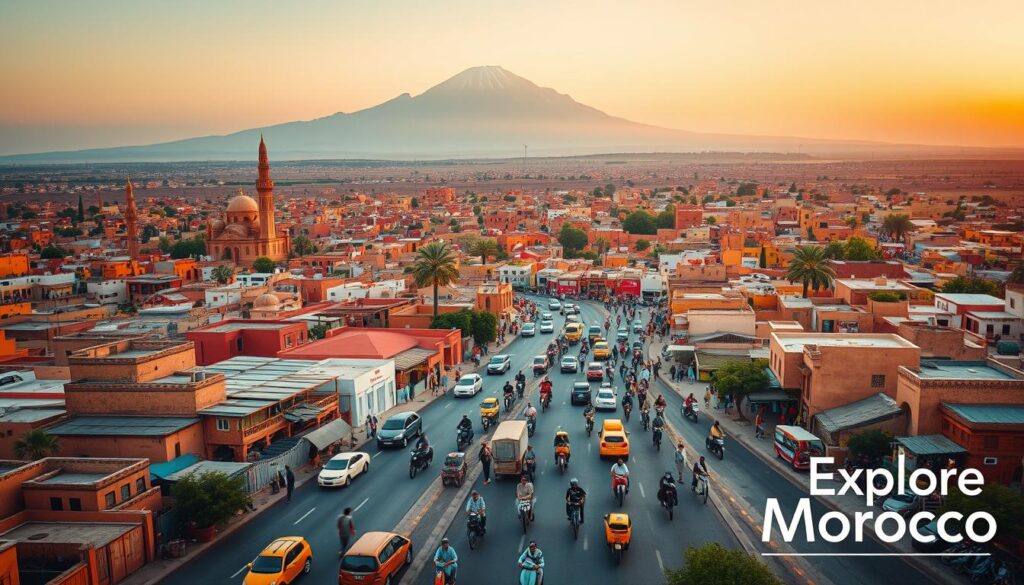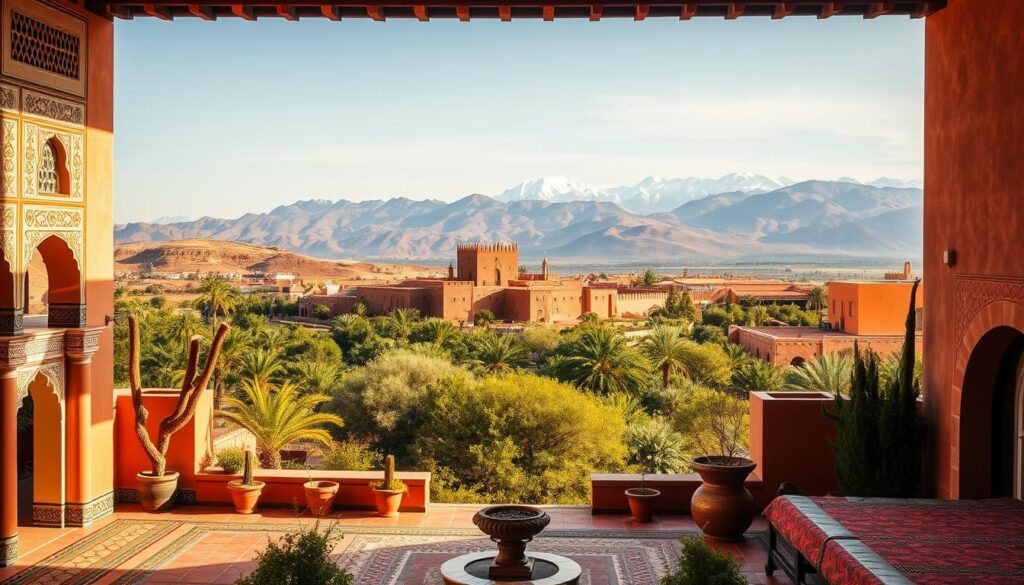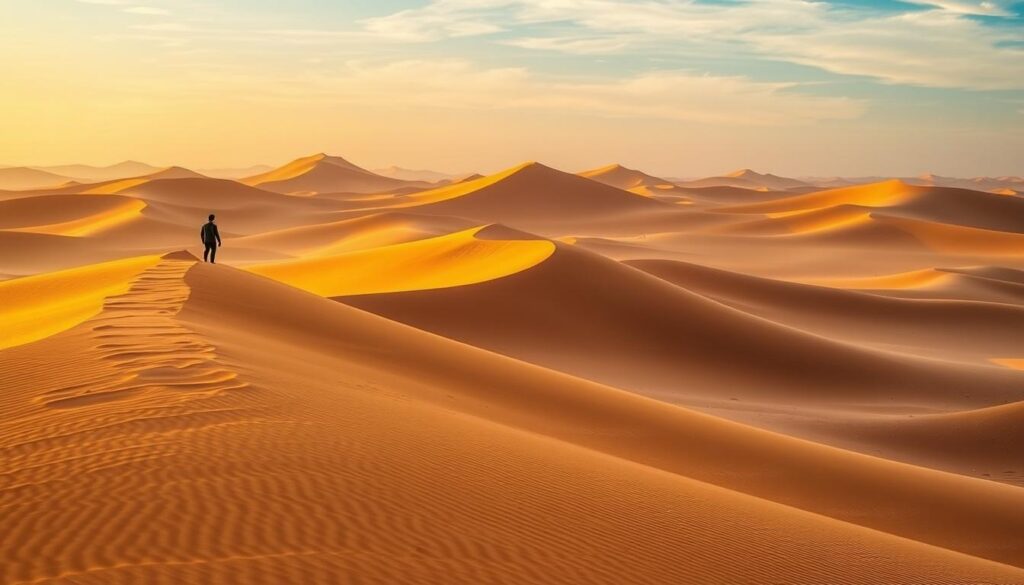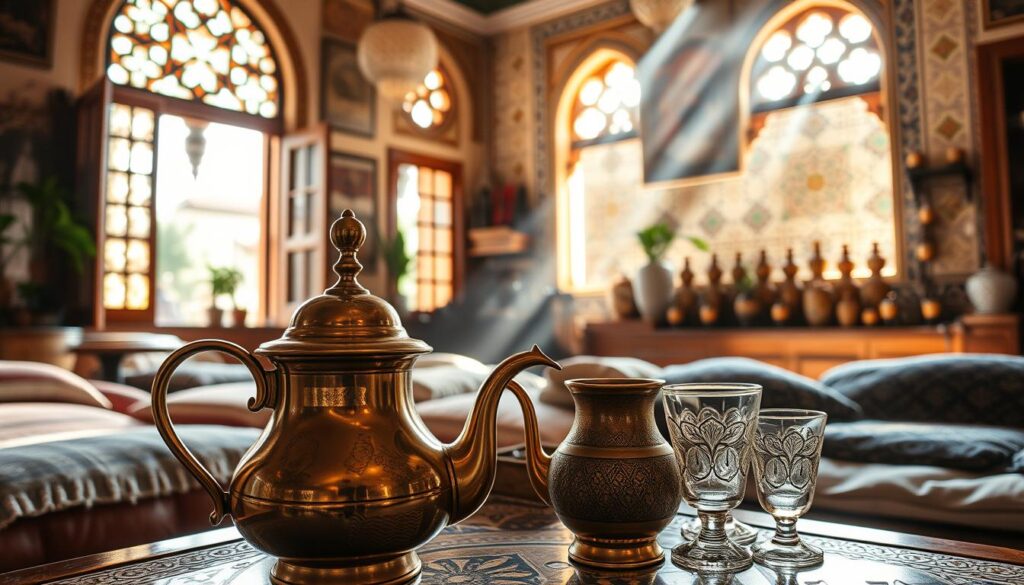Your Ultimate Morocco Trip Planner: Everything You Need
Ever wondered how one country can offer bustling cities, golden desert dunes, and centuries-old culture all in a single journey? Morocco blends Arab, Berber, and European influences into an unforgettable travel experience.
From navigating historic medinas to trekking the Sahara, planning your itinerary requires smart insights. This guide covers visas, transportation, and seasonal tips to make your adventure seamless.
Discover iconic spots like Jardin Majorelle and the Erg Chebbi dunes. With 17 detailed sections, we’ll help you explore every corner of this vibrant country.
1. Do You Need a Visa for Morocco?
U.S. passport holders can explore Morocco visa-free for short stays. The country welcomes American travelers for up to 90 days without a visa, making it an easy addition to your itinerary.
Visa Requirements for U.S. Travelers
Your passport must be valid for at least six months beyond your arrival date. This rule applies even if your trip is shorter. Always double-check expiration dates to avoid last-minute issues.
Other nationalities should verify entry rules with their local embassy. Some visitors may need to apply for a visa in advance.
COVID-19 Travel Restrictions
Morocco lifted all pandemic-related entry rules in 2024. No vaccination proof or testing is required, regardless of your routes.
Ferry arrivals from Spain follow the same guidelines. Policies rarely change, but checking embassy updates saves time and stress.
2. Where Is Morocco and How to Get There
Nestled between the Atlantic Ocean and the Mediterranean, Morocco is easily accessible from major U.S. hubs. Its proximity to Spain makes it a convenient stop for multi-country travel itineraries.
Major Airports and Airlines
Casablanca (CMN) and Marrakech (RAK) are the primary entry cities. Delta and Emirates offer direct flights from New York, while United serves only Casablanca. Budget airlines like Ryanair connect European hubs to Marrakech.
Airport transfers are straightforward. Trains run from CMN to Casablanca’s city center in 45 minutes. For RAK, taxis or pre-booked shuttles are best.
Ferry Options from Spain
Fast ferries from Algeciras or Tarifa to Tangier take 60–90 minutes. These routes are ideal for travelers exploring southern Spain. For a scenic journey, the Barcelona-Tangier ferry (28–36 hours) allows vehicle transport.
Combining flights and ferries saves time. Fly into Madrid, then take a short ferry to Tangier. This works well for multi-country adventures.
- Quick tip: Book ferry tickets online to avoid port delays.
- Renting a car in Tangier? Ensure your rental company permits cross-border travel.
3. Best Time to Visit Morocco
Choosing the right season unlocks this country’s full potential, from mild city walks to desert adventures. Each time of year offers unique perks, but spring and fall reign supreme for comfort and events.
Ideal Seasons: Spring and Fall
March to May and September to November deliver perfect 70–80°F days in Marrakech. These months balance sightseeing comfort with fewer crowds.
- Spring: Blooming gardens and festivals like the Rose Festival in May.
- Fall: Harvest celebrations and cooler Sahara treks (ideal for a trip).
Planning Around Ramadan
Ramadan’s dates shift yearly (March–April in 2025). While daytime dining options shrink, nights come alive with bustling markets and cultural events.
“Suhoor meals before dawn and vibrant iftar feasts offer a rare glimpse into local traditions.”
Weather Considerations by Region
Morocco’s regions vary wildly:
- Coast: Agadir stays mild (73°F in summer).
- Sahara: Avoid July’s 100°F+ heat; winter days hover at 70°F.
- Mountains: Ski the Atlas peaks December–February.
Fes and Marrakech hit 90°F+ in summer—pack sunscreen and plan indoor activities for midday.
4. Getting Around Morocco: Transportation Guide

Navigating Morocco’s diverse landscapes requires smart transportation choices. From high-speed trains to desert routes, each option suits different travel styles and budgets. Here’s how to move seamlessly between cities and remote areas.
Trains: Comfortable and Affordable
ONCF trains connect major cities like Casablanca, Fes, and Marrakech. Book 1st class for air conditioning and spacious seating. Schedules are reliable, with fares starting at $15 for a 3-hour ride.
- Pro tip: Use the ONCF website for real-time updates and e-tickets.
- Multi-city passes save time for longer itineraries.
Buses: Slow but Extensive
CTM and Supratours serve remote areas where trains don’t reach. CTM buses offer Wi-Fi and reclining seats, while Supratours is cheaper but less comfortable.
| Company | Amenities | Price (Marrakech to Fes) |
|---|---|---|
| CTM | AC, Wi-Fi, luggage storage | $20 |
| Supratours | Basic seating | $12 |
Taxis: Petit vs. Grand Taxis
Street taxis (petit) fit 3–4 passengers and run on meters in cities. Grand taxis are shared vehicles for intercity travel, seating up to six. Always negotiate fares before boarding.
In urban areas, the Careem app works like Uber. Near hotels, staff can help flag down reliable drivers.
Domestic Flights for Long Distances
Royal Air Maroc links Casablanca to Ouarzazate and Dakhla. Flights are ideal for Sahara access or coastal routes. Book early—seats fill fast for under $100 one-way.
Renting a car? Opt for 4×4 in mountain or desert regions. Rural roads often lack signage.
5. Language and Communication Tips
Language bridges gaps in travel, and Morocco’s linguistic diversity reflects its rich culture. While navigating medinas or chatting with locals, a few key phrases and tools can smooth your journey.
Common Languages Spoken
Moroccan Arabic (Darija) and Berber dialects dominate daily life. French is widely used in business and street markets, while Spanish pops up in northern regions. Essential phrases to know:
- Shukran (Thank you)
- Labas? (How are you?)
- Bikhir? (Is everything okay?)
“Google Translate’s offline mode saved me in Fes’ medina—especially for haggling over pottery.”
English in Tourist Areas
Per 2023 surveys, 33% of tourism industry workers speak basic English. Major sites like Hassan II Mosque have multilingual signs, but rural areas require patience or a guide. Pro tips:
- Use French in riads and cafes—it’s more common than English.
- Download Darija audio guides for solo exploration.
- Hire local guides for complex interactions (e.g., desert tours).
Smiles and gestures go far, but learning even a few words delights locals and deepens your connection to the culture.
6. Money Matters: Currency and Payments
Money matters can make or break your experience in this country—here’s how to handle them. Whether you’re bargaining in a street market or checking into luxury hotels, understanding local payment methods saves time and stress.
Moroccan Dirham (MAD) Basics
The dirham is Morocco’s official currency, with $1 ≈ 10 MAD. Exchange money at airports for fair rates—avoid hotels or unlicensed vendors. Remember: Dirhams can’t be traded outside the country, and exporting over 1,000 MAD is illegal.
Cash vs. Credit Card Usage
Cash rules in medinas and rural areas. ATMs are plentiful, but skip Euronet to dodge high fees—BMCE Bank offers better rates. For cards:
- Visa/Mastercard: Accepted at upscale shops and riads.
- AMEX: Rarely works—carry a backup.
Pro tip: Start haggling at 30% of the asking price. Vendors expect negotiation, but always use MAD for deals.
“I saved 40% on a leather bag by paying cash—vendors often drop prices to avoid card fees.”
Plan your trip budget with 70% cash for tips, taxis, and markets. Use cards for hotels or car rentals to simplify receipts.
7. How to Dress in Morocco
Understanding dress codes in Morocco helps travelers blend in and connect with the culture. Whether exploring cities or sacred sites, respectful attire opens doors to deeper interactions with locals.
Modesty Guidelines for Visitors
Moroccan customs favor covered shoulders and knees, especially in urban areas. Women often wear maxi skirts or loose tunics, while men can opt for knee-length shorts in cities like Marrakech.
Breathable fabrics like linen work best for Morocco’s heat. Closed-toe shoes are ideal for medina cobblestones. Pack layers for the Sahara—nights can drop to 40°F.
What to Wear in Mosques
Most mosques require conservative attire. At Hassan II Mosque, scarves are provided for women, and shoes must be removed. Men should avoid sleeveless shirts.
| Activity | Recommended Attire |
|---|---|
| City Exploration | Loose pants, tunics, sandals |
| Mosque Visits | Long sleeves, headscarves (women) |
| Desert Trips | Layered clothing, sturdy shoes |
“A lightweight scarf doubled as a sun shield and modesty cover—essential for my Medina walks.”
Respecting dress norms shows appreciation for Morocco’s culture. It also ensures comfort during visits to mosques and markets.
8. Where to Stay: Accommodation Options

Your choice of lodging shapes your Moroccan adventure as much as the destinations themselves. Whether you prefer traditional riads or modern hotels, each option offers unique ways to connect with local culture.
Riads: Traditional Guesthouses
Converted from historic homes, riads like Marrakech’s Riad Almaha feature courtyard pools and handcrafted tilework. These intimate stays put you steps from medina markets while offering peaceful retreats.
Dar Zerhoune in Moulay Idriss exemplifies rural riads with mountain views. Compared to chain hotels, riads excel at personalized service—think homemade breakfasts and tea ceremonies.
“Waking up to birdsong in a riad’s orange tree courtyard became my favorite travel memory.”
Modern Hotels and Resorts
For urban luxury, La Maison Arabe combines cooking classes with a hammam spa. Jnane Tamsna’s rooftop dining showcases Black-owned hospitality in Palmeraie.
High-end hotels cluster outside medinas:
- Royal Mansour: Private riad suites with butler service
- Four Seasons: Family-friendly pools near golf courses
Desert stays shine in Merzouga, where glamping camps offer ensuite bathrooms under starry skies. Film buffs love Aït Benhaddou’s kasbah lodgings—some appeared in Gladiator and Game of Thrones.
9. Top Cities to Visit in Morocco
From coastal metropolises to ancient medinas, Morocco’s cities captivate with their diversity. Each offers a distinct slice of the country’s heritage, whether through towering mosques, labyrinthine souks, or vibrant street life. Here’s where to focus your itinerary for an unforgettable urban adventure.
Casablanca: Modern and Historic
Casablanca blends sleek skyscrapers with colonial architecture. The Hassan II Mosque, seating 25,000 worshippers, is a must-see—guided tours ($13) reveal its intricate mosaics and ocean-view terrace.
- Corniche nightlife: Beachfront bars and seafood restaurants buzz after sunset.
- Moroccan Judaism Museum: Explores the country’s Jewish history through artifacts and oral histories.
Fes: Ancient and Cultural
Fes el-Bali, the world’s largest medina, feels frozen in time. Visit the Chouara Tannery, where free mint leaves ease the pungent dye smells, and haggle for leather goods.
“The Bou Inania Madrasa’s carved cedar ceilings and Quranic inscriptions are a masterclass in Islamic art.”
Local guides are wise investments here—narrow alleys can confuse even seasoned travelers.
Marrakech: Vibrant and Tourist-Friendly
Marrakech’s red walls hide lush gardens and bustling squares. The Bahia Palace’s photo-worthy courtyards contrast with the YSL Museum’s bold modernism.
- Day trips: Essaouira’s windswept beaches (2.5 hours west) or the Atlas Mountains’ waterfalls.
- Djemaa el-Fna: By night, this street square transforms with storytellers and food stalls.
For history buffs, a day trip to Volubilis’ Roman ruins from Meknes reveals Morocco’s layered past.
10. Exploring the Sahara Desert

Few places on earth rival the silence and scale of Erg Chebbi’s windswept landscapes. The Sahara Desert here feels timeless, with sand dunes rising like golden waves under endless skies. Whether you ride a camel at sunset or sleep under the stars, this region delivers an unmatched experience.
Merzouga and Erg Chebbi Dunes
At 160 meters tall, Erg Chebbi’s dunes are Morocco’s most iconic. Sunset camel rides ($25–$50) showcase their shifting colors—amber to deep crimson. For photographers, golden hour lights the curves perfectly.
Reach Merzouga via:
- 4×4 from Ouarzazate: Scenic but bumpy (6–7 hours).
- Buses from Marrakech: Affordable but slower (10+ hours).
Camel Treks and Glamping
Luxury camps like Desert Luxury Camp blend adventure with comfort. Private bathrooms and king-sized beds defy desert stereotypes. Pack smart:
- Headlamps for nighttime walks.
- Reusable water bottles (camps provide refills).
- Sand-proof bags for cameras.
“Berber drumming sessions around campfires turned our glamping night into a cultural journey.”
Extend your experience with 3-day tours stopping at Aït Benhaddou. By day, hike dunes; by night, capture the Milky Way with long exposures.
11. Must-See Natural Wonders
Beyond bustling medinas, Morocco’s landscapes reveal the country’s wild soul. Towering peaks, dramatic gorges, and cascading waterfalls showcase nature’s artistry across every region. Whether you seek adrenaline or serenity, these wonders make any journey unforgettable.
Atlas Mountains: Hiking and Scenery
North Africa’s highest peak, Mount Toubkal (4,167m), challenges trekkers with 2-day ascents from Imlil. Local guides provide mules for gear, while Berber guesthouses offer mint tea breaks. For shorter adventures, the Aremd Valley’s apple orchards deliver panoramic views without the climb.
Multi-day routes like the Mgoun Circuit reveal hidden valleys and nomadic camps. Pack layers—temperatures swing from 80°F days to freezing nights. Spring (April–June) avoids summer crowds and winter snow.
Dades Valley and Todra Gorge
The “Road of 1,000 Kasbahs” winds through Dades Valley’s red-rock canyons. Stop at Kelaa M’gouna’s rosewater distilleries or Aït Arbi’s cliffside cafes. Further east, Todra Gorge’s 300m limestone walls attract rock climbers and photographers.
- Ouzoud Waterfalls: Boat rides ($5) take you into the mist beneath 110m cascades.
- Ifrane National Park: Spot endangered Barbary macaques in cedar forests.
- Local guides: Hire muleteers for authentic Berber village treks.
“Sunrise at Todra Gorge turns the cliffs molten gold—worth the 5 AM wake-up call.”
These natural treasures showcase Morocco’s diversity. From Atlas summits to desert oases, each region offers a unique way to connect with the land and its people.
12. Moroccan Cuisine: What to Try

Moroccan flavors are a feast for the senses, blending spices and traditions. Meals here reflect centuries of Arab, Berber, and Mediterranean influences. Whether dining in a riad or at a street stall, every dish tells a story.
Signature Dishes You Can’t Miss
Tagine and couscous are the stars of Moroccan kitchens. Tagines slow-cook meats with apricots or olives, while couscous pairs with veggies and saffron. For a unique twist, try pastilla—a flaky pigeon pie dusted with cinnamon at Café Clock.
| Dish | Key Ingredients | Where to Try |
|---|---|---|
| Tagine | Lamb, prunes, almonds | Family-run Marrakech eateries |
| Rfissa | Lentils, chicken, fenugreek | Fes medina food tours |
| Zalouk | Eggplant, tomatoes, garlic | Coastal cafes in Essaouira |
Street Bites and Tea Traditions
Jemaa el-Fnaa’s stalls serve snail soup ($1) and chebakia (sesame cookies for $0.50). For a deeper dive, join La Maison Arabe’s tagine workshops—they teach spice blends and slow-cooking techniques.
“Mint tea poured from a height isn’t just refreshing—it’s a symbol of hospitality. Locals say the foam measures a host’s generosity.”
Vegetarians will find plenty of options like zalouk, but vegan dishes are rare. Always ask about meat broths in soups. For locals, sharing meals is a custom—expect communal platters and seconds offered warmly.
13. Cultural Etiquette and Tips
Cultural awareness transforms simple interactions into meaningful connections. Morocco’s social customs blend Islamic traditions with Berber hospitality, creating unique expectations for visitors. A few thoughtful gestures help you engage respectfully with locals while avoiding unintended offenses.
Mastering Market Bargaining
Souk vendors expect negotiation—it’s part of the street market culture. Start by offering 30% of the initial price, then meet halfway. Walking away often triggers better counteroffers.
Cash works best for deals. Vendors may inflate prices if you pull out a credit card. Remember: friendly haggling is normal, but aggressive tactics offend.
Navigating Social Interactions
75% of Moroccans consider prolonged eye contact impolite, especially between genders. Brief glances show respect without seeming confrontational.
“My guide taught me to greet older shopkeepers with a hand over my heart—this small gesture earned warm welcomes everywhere.”
- Photography ethics: Always ask permission before photographing people. In medinas, some artisans request small tips for portraits.
- Tipping norms: 10% in restaurants, 5-10 MAD for guides. Round up taxi fares to the nearest 5 dirhams.
- Mosque visits: Non-Muslims can’t enter most prayer areas, but Hassan II Mosque offers guided tours.
- Gender norms: Men should wait for women to initiate handshakes. Conservative areas prefer nods or hand-over-heart greetings.
- Festival tips: During Eid al-Fitr, expect closures and book accommodations early. Locals appreciate Ramadan greetings like “Ramadan Mubarak.”
14. Shopping in Morocco
Morocco’s markets are treasure troves of craftsmanship, where every purchase tells a story. The artisan industry thrives in medina alleys, offering everything from hand-stitched leather to cobalt pottery. Unlike typical retail, shopping here blends cultural discovery with the thrill of negotiation.
Best Souvenirs: Leather, Pottery, and Textiles
Fes’ Chouara tanneries produce buttery-soft babouches (slippers) for $15–$30. Look for vegetable-dyed pieces—their rich colors last longer. Marrakech’s Rahba Kedima square dazzles with ceramic tagines, while Essaouira’s cooperatives sell fair-trade argan oil.
| Item | Where to Buy | Fair Price Range |
|---|---|---|
| Hand-painted pottery | Safi workshops | $8–$25 |
| Berber rugs | Atlas Mountain villages | $80–$400 |
| Silver jewelry | Tiznit souks | $20–$150 |
Top Shopping Destinations
In Fes, the street markets near Bou Inania Madrasa specialize in geometric zellige tiles. Government-run Ensemble Artisanal in Marrakech fixes prices—ideal for stress-free purchases.
Rabat’s Oudayas market shines for woven baskets. Hotel concierges often know hidden ateliers where artisans work onsite. For bulk spices, Marrakech’s Mellah district beats touristy Jemaa el-Fna stalls.
“My hand-embroidered kaftan from a Fez backstreet cost half the medina price—always explore side alleys.”
DHL outlets in major cities simplify shipping large items. Keep receipts for customs declarations on high-value rugs or antiques. Remember: bargaining starts at 50% off initial quotes in street markets, but fixed-price stores ensure transparency.
15. Sample Morocco Itineraries
Tailored itineraries help travelers experience this North African gem’s diversity without feeling rushed. Whether you seek quick city highlights or deep cultural immersion, these routes maximize your days while leaving room for spontaneous discoveries.
7-10 Days: Highlights Tour
This fast-paced loop covers imperial cities and desert wonders:
- Day 1-2: Arrive in Casablanca, visit Hassan II Mosque, train to Fes
- Day 3-4: Explore Fes’ medina, day trip to Meknes ruins
- Day 5: Sahara overnight via Merzouga (sunset camel trek)
- Day 6-7: Drive to Marrakech via Aït Benhaddou, relax in riad
“We added Essaouira for coastal breezes—perfect after Marrakech’s heat. The 10-day version lets you breathe between stops.”
2-3 Weeks: Comprehensive Exploration
Extended travel reveals regional contrasts:
- Northern add-ons: Chefchaouen’s blue alleys (2 days) + Tangier’s international art scene
- Southern routes: Draa Valley palm oases + Taroudant’s relaxed souks
- Festival timing: Align with May’s Rose Festival or July’s Timitar music event
| Itinerary Type | Best For | Avg Daily Cost |
|---|---|---|
| 7-day highlights | First-time visitors | $120–$250 |
| 14-day deep dive | Cultural immersion | $90–$200 |
| Luxe 10-day | 5-star experiences | $400+ |
Road trippers can customize coastal drives from Tangier to Essaouira. Allow extra days for Atlas Mountain hikes or spa retreats in Ouarzazate.
Conclusion
The magic of Morocco lies in its contrasts—ancient traditions meet breathtaking landscapes. From bustling cities to silent deserts, this country crafts a unique experience at every turn.
For authentic stays, book riads or hire local guides. They unlock hidden gems and deepen your connection to the culture. Respect customs like modest dress and haggling politely in markets.
Extend your journey with side trips to Spain’s Costa del Sol or the Canary Islands. Both are short flights away.
Before you go, double-check:
– Universal adapters for Type C/E plugs
– Travel insurance covering desert excursions
– Photocopies of your passport
Ready? Morocco’s wonders await—pack light, but bring curiosity.

